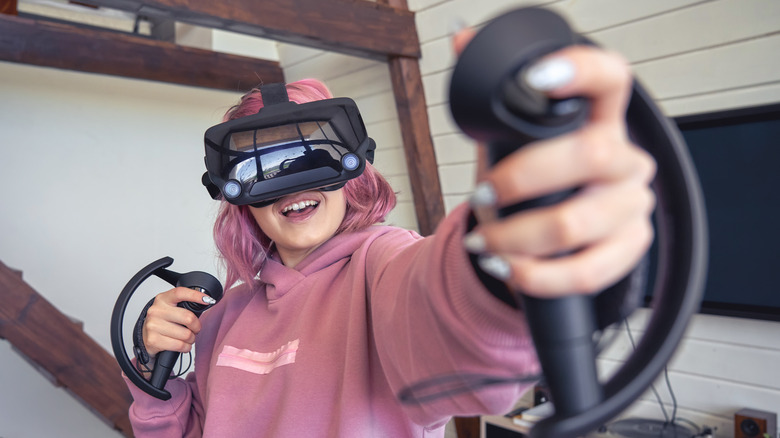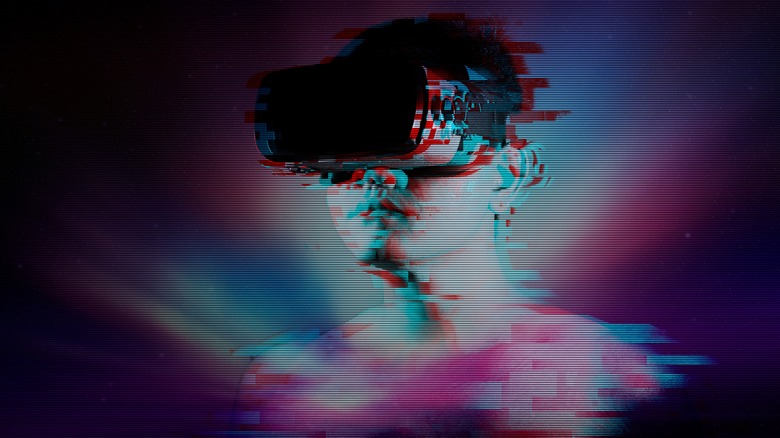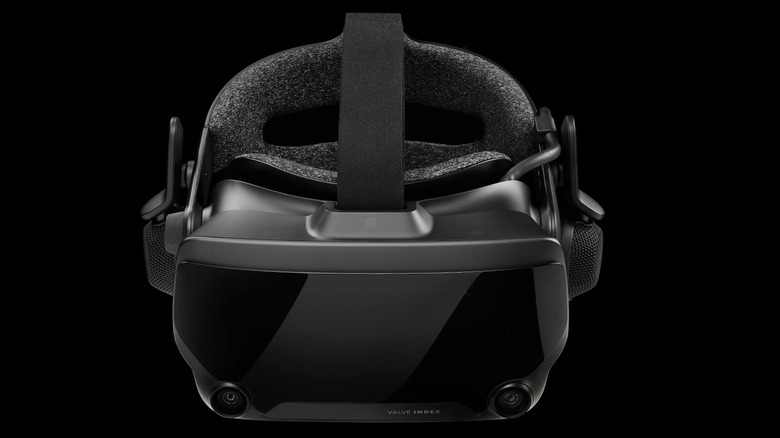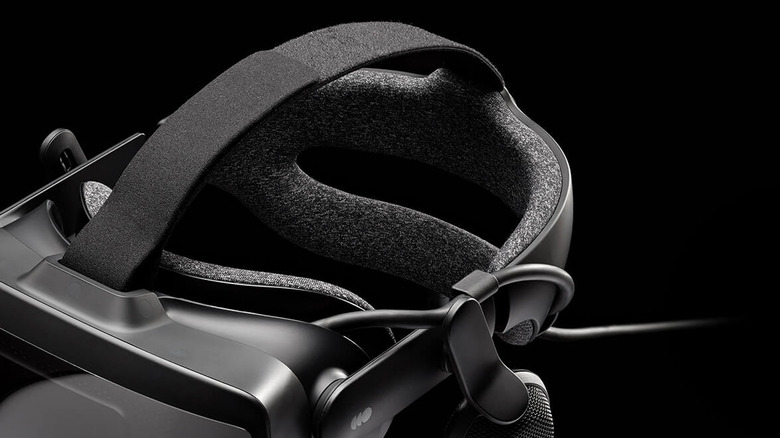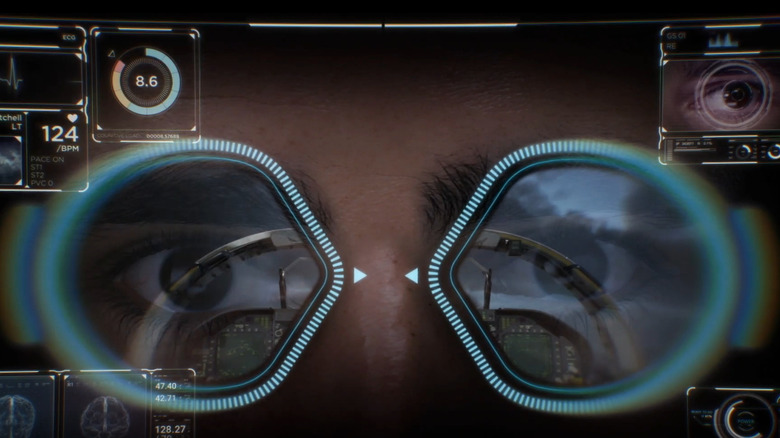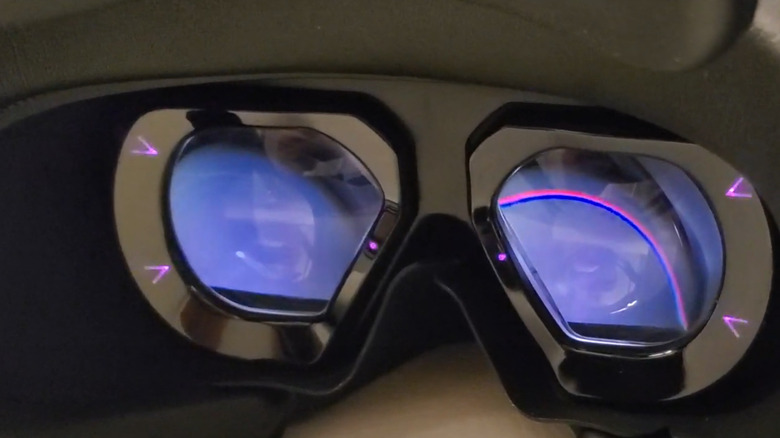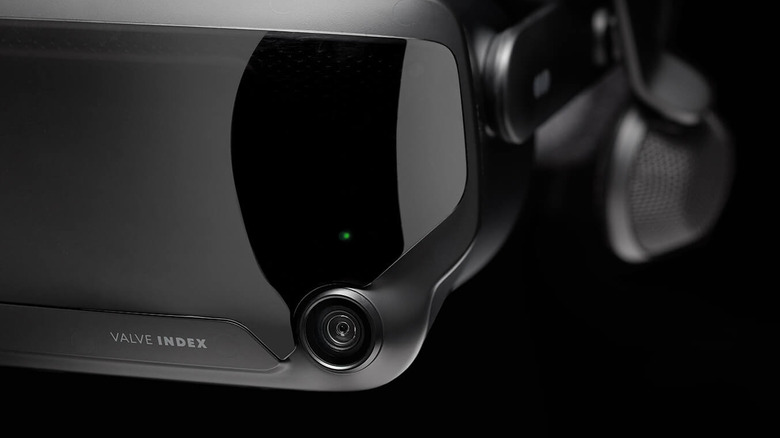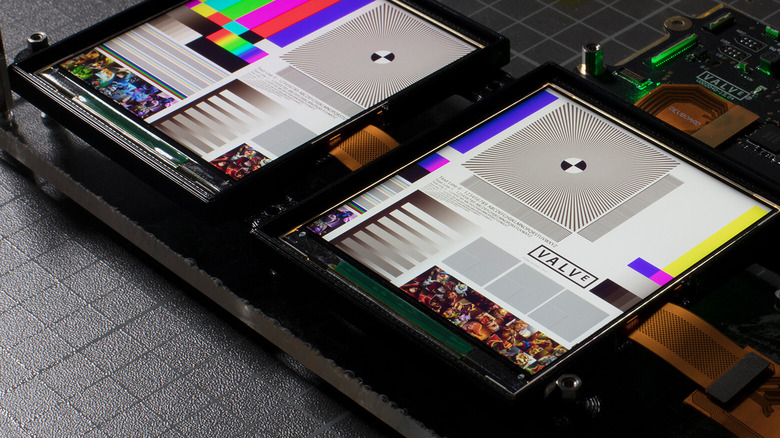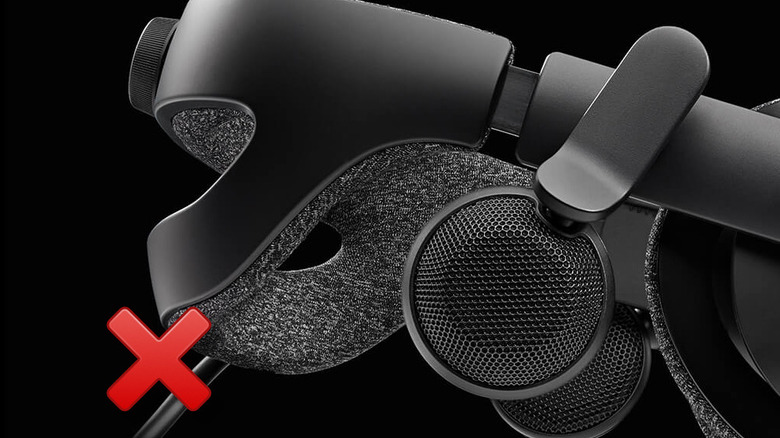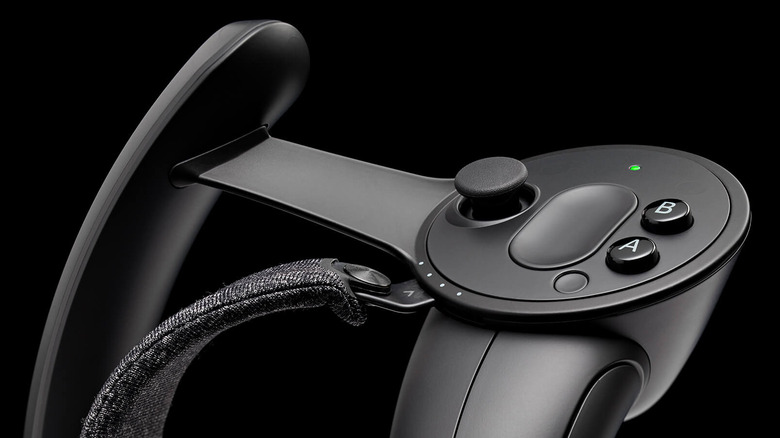Features We Want To See From A Valve Index 2 VR Headset
Valve Software has been at the bleeding edge of PC gaming since its inception in 1996 by two ex-Microsoft employees, Gabe Newell, and Mike Harrington. The company popularized the game launcher model for selling and launching PC games from the same program with its publication platform, Steam. First created as an anti-piracy measure for "Half-Life 2" and only containing Valve's software, it now publishes games from most PC developers. The company didn't only create software and a distribution platform. In 2019, the Valve Index Virtual Reality headset was released to the world.
The high-end headset required a high-end PC to power it, base stations for tracking the user, and expensive controllers for motion control. The whole package costs $999, but that didn't stop it from constantly selling out. The Index is now the second-most-popular VR headset on the Steam Hardware & Software Survey, only behind the wildly-popular Meta Quest 2, which owes a large percentage of its popularity to the fact it costs substantially less than other headsets.
With how popular the Index has been, it's a fair bet that Valve is working on an Index 2 VR headset. While the first device was a resounding success, we have thoughts about how the second iteration could be even better.
Things we already know
Valve hasn't publicly said that it is working on Index 2. That's not unsurprising, as the company is often tight-lipped about projects that are in development. What has shown up is a patent granted by USPTO on June 16, 2022, showing an unknown VR headset, with more adjustability in the straps than the current Valve Index. These patent drawings also show the headset not having a tethering cable at all times. The text mentions wireless VR streaming to the headset as a possible option. That's not enough to show that Valve is working on a standalone VR headset similar to the Meta Quest 2, but it does show that the company is thinking about it.
VR analyst Brad Lynch found changed code inside SteamVR that indicated Valve is working towards a standalone headset. Codenamed "Deckard," the headset has code for Wi-Fi, which was completely absent on the Index. The code also indicates a Snapdragon chip for running an operating system on the headset, all things you'd expect from a standalone, wireless VR headset. A job listing from October 2022 asked for "versatile, self-directed software engineers in computer vision who can help us achieve the next steps in VR with millions of customers worldwide." That confirms that Valve is working on a new VR device, and one that could be using inside-out tracking for controller-less control.
A standalone version
The most popular VR headsets, like the Meta Quest 2 and Pico 4, are all standalone, meaning they don't need to be tethered to a PC for exploring virtual worlds. They can still be tethered via USB-C, bringing the additional power of the PC to give better performance in virtual reality apps and games. Valve already has one of the best tethered VR headsets, and rumors from 2021 said Valve could be working on a standalone version in the future. Even a version that can work wirelessly from the PC would be a welcome addition.
Think how Valve's Steam Deck can be used portably and also docked. Unlike a standalone VR headset, the Steam Deck doesn't have more power when docked. Valve decided to optimize the handheld for portable gaming use so you get the same performance at all times. A tetherable VR headset would be different, pushing more frames when connected to a PC through a USB-C cable or Wi-Fi.
More comfort
VR headsets aren't comfortable, with bulky visors that need to be balanced out by weights at the back of your head. The Index weighs 809g, which is high for currently available VR headsets. Anything Valve can do to lower the weight of the Index 2 would go a long way to making it more comfortable, even without changing ergonomics. Better weight distribution between the front and the back of the headset would also be welcome, which could be achieved in a standalone headset by adding the battery compartment to the straps. Adding more customizable straps to fit the headset to more head sizes would also improve things.
Valve was granted a patent in 2022 that showed three different VR headsets, all with more customizable straps. These showed each strap on the headset with adjustable wires and pulleys, with buttons on each for ease of use. The patent also mentioned other aspects of comfort that are often overlooked, like ways to distribute heat and weight more evenly, which would translate into being able to wear the headset for longer periods of time. The customizable straps would also mean more people could use the headset. We'd like Valve to go further with multiple strap material options like moisture-wicking velour or soft lambskin leather. Replaceable and adjustable face pads could reduce light bleed from the outside world while alleviating pressure on the sensitive eye and nose region.
Hand tracking
Valve's 'knuckles' controllers are great, but the controllers can get heavy over time. Hand tracking is a recent addition to the VR headset, which uses the cameras outside of the headset to keep tabs on where your hands and fingers are and what they are doing. This is driven by advances in AI and motion tracking via purely camera-based systems and is fine-grained enough to show individual fingers typing on a keyboard and which keys they tap.
Adding more cameras outside the Index 2 could mean Valve supporting hand tracking, making controllers no longer necessary. Not that we want Valve to ditch their controllers completely, which are among the most usable on the market. The option to move through menus and other simple tasks via waving our hands could push VR acceptance into the mainstream.
We've seen this from the current market leader, Meta, on its Quest 2 standalone headset. Humans have thousands of years of evolution to use our hands as the primary way of interacting with the world. There is no reason that we couldn't navigate the virtual world in the same way.
Eye Tracking
Many premium VR headsets now have eye tracking to recreate facial expressions and enable foveated rendering, which cuts down on the power needed to render a view by only rendering the section you are directly staring at in high resolution. According to the XR Industry Report 2019, the third-most-desired function driving XR and VR adoption is eye tracking, behind improvements to field-of-view and headset comfort and usability.
Most VR and XR headsets use eye-tracking hardware from Tobii. These sensors enable eye-based navigation through menus and other UI elements and feedback to developers about cognitive load. They can also be used for collaborative efforts, showing participants in group chats where the rest of the group is looking.
For Index 2, eye-tracking would enable foveated rendering, reducing the processor load on the headset when in standalone mode. That would also cut down on the resources needed to use the headset in tethered mode with a PC, possibly making it usable with the Steam Deck for truly portable VR gaming. Valve could take this further, with in-game characters that respond to the player differently based on the facial expressions the sensors record.
Automatic IPD adjustments
The Index has manual interpupillary distance (IPD) adjustments to improve the image for the user and reduce the VR queasiness some users feel more than others. If eye tracking is included, Valve can also add motors to change the IPD automatically, as the tracking optics can measure the user's eyes when they put it on. This takes any possibility of user error out of the equation so that Index 2 can give the best image quality to every person that puts one on.
The technology is already in the market. Heavyweight manufacturer Varjo has automatic IPD adjustment on all headsets, from the $1990 Aero to the flagship XR-3, which costs $6,495 to buy and requires a $1,495 yearly subscription to continue using. Varjo's implementation also tells the user if the headset is too high or too low on their face, showing which direction to move it to get in the optimal position. The automatic adjustments work even when the user is wearing single-vision glasses, making complicated VR setup processes a thing of the past.
Inside-out tracking
The rest of the VR world is putting cameras all over their headsets and controllers to track them from the inside out instead of needing expensive base stations that take up space in the room. That's the Meta Quest Pro system, where each controller has three cameras to keep track of where they are in 3D space. The controllers each have a midrange Snapdragon processor to handle tracking, so the headset's power can be used for the displayed software. The other benefit is that the controllers can be lighter, as they don't need the large loops used for tracking.
Valve could do that, too, making the controllers track even while out of view of the cameras on the headset while keeping track of where you are in the virtual world. Imagine walking between rooms in your house and between virtual rooms simultaneously – something impossible with the Index's current reliance on base stations. The Index already has two front-facing cameras that are used for tracking the user's position in real space and passing through a view of reality in mixed-reality scenarios. More cameras on the headset would enable even better positional tracking, hand tracking, and object tracking — without needing lighthouse base stations.
Better optics
High-end VR headsets like the Varjo Aero have large pixel counts with two Mini LED LCDs at 2880 x 2720 pixels, one for each eye. The Index currently uses 1440 x 1600 per eye at a refresh rate of 144Hz. The LCD panels Valve used in the Index have relatively low brightness, measured at 95 nits. That's compared to 143 nits for the Vive Pro or 214 for the original Vive. Clearly, something needs to change for Index 2 for Valve to stay at the forefront of the industry.
Valve could drastically improve the pixel count of Index 2, either with Mini LED or OLED, and the visuals displayed will benefit. Apple is rumored to have 8K resolution panels on each eye for its upcoming headset. Valve might not want to play in that price bracket, but improving on the Index's relatively low pixel count is a must. Changing the panel type would also mean the brightness levels could be improved. OLED or QD-OLED would improve contrast, HDR performance, and color accuracy from the LCD panels.
Better connectivity
The Valve Index uses DisplayPort 1.2 for its tethered connection to the PC. This is an aging standard, with most of the industry now using DisplayPort 1.4 or HDMI 2.1 for their wired connectivity. AMD is now using DisplayPort 2.1 on its RDNA 3 graphics cards, so maybe Valve could start there for wired connectivity. That's one option, or the wired tether could be done over USB 4 or ThunderBolt 4 through a USB-C port. That would make it compatible with a broader range of devices, from Windows PCs to the Steam Deck to Apple's Mac and MacBook ranges.
With the rumors saying Index 2 will be a standalone headset, we'd also like to see Wi-Fi 6E or even Wi-Fi 7, depending on how long out the launch of the headset is. That will improve the user experience when using Steam VR in wireless mode. Wireless connectivity for headsets would also be a plus, so Bluetooth 5.2 at a minimum or whatever version of Bluetooth is available at launch.
Controllers with replaceable batteries
The current Index controllers have inbuilt rechargeable batteries with eight hours of life, per the manufacturer. That's decent battery life, but if you forget to charge them overnight, you could lose charge during your gaming session. Removable batteries would fix that, enabling you to switch to fresh ones at a moment's notice. Using AA batteries would be a good start, which is what competitor Pico did with their fourth headset.
Valve could score points for usability while also gaining kudos for being environmentally conscious by moving to replaceable batteries. The only way to repair Index controllers if the inbuilt batteries fail is by sending them into Valve. That not only creates a single point of failure on the controllers and a single solution – it increases carbon emissions with the device needing to be shipped long distances twice – all for simply replacing a battery.
If AA batteries don't meet the necessary power requirements, Valve could make a battery pack with USB-C charging that can be replaced so that users can charge spare packs to swap in once the charge levels on the installed packs drop.
First-party games
Sony's PSVR2 headset has multiple first-party games coming at launch, from entirely new titles like "Horizon: Call of the Mountain" to VR-ready games like "Gran Turismo 7." Valve created "Half-Life: Alyx" a year after the release of the original Index but hasn't made any new titles since. We'd love to see them return to their game development roots for Index 2.
The company has a proven track record for making hit games. "Half-Life 2" launched the Steam publishing and development platform, and another big first-party title could be exactly what consumer VR needs to gain widespread adoption. "Half-Life: Alyx" wasn't even a full-length game, and it still made it so that Valve had trouble keeping the Index in stock after the game's release. Steam VR has over 4,000 titles currently available in the storefront, but only a handful of first-party VR experiences. That's hinging the success of Index 2 on third-party developers to bring consistently compelling experiences to the Steam storefront. Do you know what Valve could release as a Day One Index 2 title? "Portal" and "Portal 2" but fully playable in VR. That would shift hardware units for sure.
